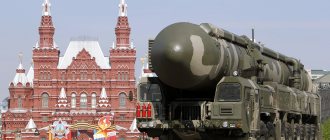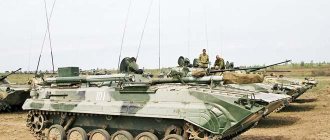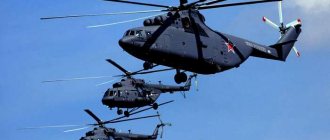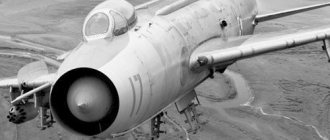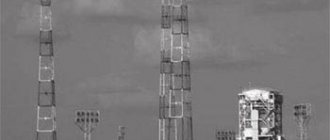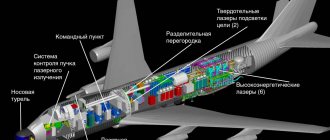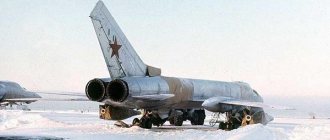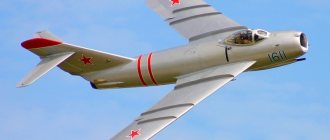UR-100: how Secretary General Khrushchev chose the most popular missile of the Strategic Missile Forces (part 2)
“... And for missile defense”
Thus, the fate of the future “Soviet Minuteman” was actually decided - the first light intercontinental ballistic missile of the ampoule type in the history of the USSR. The word of the then General Secretary of the CPSU Central Committee Nikita Khrushchev determined the outcome of the rivalry between Yangel and Chelomey - at that stage. Here's what it looks like in the docs.
Loading an 8K84 rocket into a TPK into a silo launcher and a view of the silo head with an open protective device.
Photo from the site https://www.arms-expo.ru On March 23, 1963, the CPSU Central Committee sent a cover letter to the draft resolution on the start of work on a “light” intercontinental ballistic missile. It was signed by Deputy Chairman of the Government Commission on Military-Technical Issues Sergei Vetoshkin (the second person in this department after Dmitry Ustinov), Marshal Rodion Malinovsky, Head of the State Aviation Industry Committee Pyotr Dementyev, Chairman of the State Committee for Radio Electronics Valery Kalmykov, Chairman of the State Committee for Red Machinery (responsible for the entire nuclear industry) Efim Slavsky, Air Defense Commander-in-Chief Marshal Vladimir Sudets and two more marshals - Sergei Biryuzov and Matvey Zakharov, the first of whom was then the commander-in-chief of the Strategic Missile Forces and literally a few days later replaced the second, who held the post of Chief of the General Staff of the USSR Armed Forces. This is what his text was:
"Owl" secret Central Committee of the CPSU In accordance with the instructions of the Central Committee of the CPSU, we present a draft Resolution on the development in OKB-52 of the State Committee of the Council of Ministers of the USSR for Aviation Technology of an automated missile system with a universal product UR-100 ampoule type with a simplified silo launch. A proposal for the development of the UR-100 complex was presented by the designers of TT. Chelomey, Pilyugin, Ryazansky, Kosberg, Mints and Raspletin. The UR-100 missile is being developed as a universal missile for hitting ground targets and for the country's missile defense. The firing range of the UR-100 missile with special charges against ground targets is from 2,000 km to 11,000 km. Firing accuracy at maximum range ± 3 km. The start date for joint testing is IV kV. 1964. The draft resolution is attached.”
The draft, which was attached to this letter, was considered just a week later at a meeting of the Presidium of the CPSU Central Committee and adopted practically without changes, turning into the famous joint resolution No. 389-140 of the CPSU Central Committee and the Council of Ministers of the USSR. It is also worth bringing it with small bills:
“Special folder of Owls. secret Of particular importance to the Central Committee of the CPSU and the Council of Ministers of the USSR dated March 30, 1963 No. 389-140 On the creation of the UR-100 missile system Attaching particular importance to arming the Soviet Army with ampoule-type missiles with a simplified silo launch, the Central Committee of the CPSU and the Council of Ministers of the USSR DECIDE: Accept the proposal of the GKAT (comrades Dementiev, Chelomey), State Committee for RE of the USSR (comrades Kalmykov, Pilyugin, Ryazansky) and the USSR Ministry of Defense (comrades Malinovsky, Biryuzov), reviewed and approved by the USSR Supreme Economic Council commission on military-industrial issues, on development in 1963–64 years of an automated missile system with a universal product UR-100 ampoule type with a simplified silo launch with the following main characteristics: the longest firing range without taking into account the rotation of the Earth - 11,000 km minimum ... - 2000 km control system - autonomous with radio correction maximum deviation when firing at the maximum range : with autonomous control system - in range - ± 5.5 km - in direction - ± 3.0 km with radio correction - in range - ± 3.0 km - in direction - ± 3.0 km special charge with automation, initiation system, contact and non-contact sensors for the greatest range - 11000 km for the minimum ... - 2000 km starting weight of the product - 35 tons engine - liquid fuel: - fuel - dimethylhydrazine - oxidizer - anhydrous nitrogen tetroxide Storage of the product filled with fuel components in the conditions of a mine starting position in readiness No. 1 - 7–10 years; Readiness No. 1 of the automated complex to launch according to a predetermined target from the moment the launch command is received is 3 minutes; Type of launch - mine automated Launch security - 2.5 kg/sq.cm. in the front of the shock wave... The development of the universal UR-100 missile is to be carried out both as a ballistic missile for hitting ground targets and for the country’s missile defense. Set the start date for joint testing of the complex with the UR-100 product - Q4. 1964 Approve as the main executors of work: on the system as a whole and the UR-100 ballistic missile - OKB-52 GKAT USSR (General Designer Comrade Chelomey) Oblige the USSR Ministry of Defense (comrades Zakharov, Biryuzov) to issue within a month, and the Civil Aviation Committee of the USSR , the Civil Code of the USSR RE within a month to review and coordinate with the USSR Ministry of Defense the tactical and technical requirements for the development of a product complex.”
Bandolier for ballistic missile
Thus, the fate of the future most massive intercontinental ballistic missile of the Soviet Missile Forces, the famous “hundred”, was decided. Alas, the “light” intercontinental missile R-37, developed by OKB-586 under the leadership of Mikhail Chelomey, has sunk into oblivion. It sank, despite the designer’s repeated appeals to the CPSU Central Committee and personally to Nikita Khrushchev with a request to fulfill the promise made in the heat of the moment in the winter of 1963 and allow the development of not one system, but two. However, soon Khrushchev himself turned into a pensioner of union importance, and Leonid Brezhnev, who took his place, had nothing to do with that promise.
The launch site at the Baikonur test site, from which the first ground launches of the UR-100 were carried out. Photo from the site https://www.arms-expo.ru
And the UR-100 missile, approved at the highest level, was hastily brought to life in metal and launched for testing. They began on April 19, 1965 at the Tyura-Tam test site (Baikonur) by launching from a ground launcher. Three months later, on July 17, the first launch was carried out from a silo launcher, and in total, before the end of the tests, that is, until October 27, 1966, the new missile managed to make 60 launches. As a result, the Soviet Strategic Missile Forces received a “light” intercontinental ballistic missile with a launch weight of 42.3 tons, of which 38.1 tons were fuel, two warhead options - with a power of 500 kilotons or 1.1 megatons and a flight range of 10,600 km (with " light" warhead) or 5000 km (with a "heavy" head).
While the UR-100 was learning to fly, OKB-52's subcontractors were working on creating the appropriate infrastructure. Branch No. 2 of the design bureau, created immediately after the decision was made to develop the “hundred”, began working on the creation of a transport and launch container (TPC) for it. After all, the rocket had to not only be ampulized, that is, filled with fuel directly at the manufacturing plant, but it had to be installed in the silo as quickly and simply as possible and not require any complex routine maintenance. This could be achieved by solving two problems. The first is to eliminate the possibility of leakage and mixing of high-boiling fuel components, which the designers achieved by installing diaphragm valves between the fuel tanks and the propulsion system. And the second is to ensure the simplest and most automated maintenance possible, for which purpose the fully assembled and fueled rocket was placed directly at the factory in the TPK, which the UR-100 left only at the moment of launch (or disassembly).
This container was one of those unique technical devices that provided the UR-100 with long military service. After the rocket took its place in the TPK, it was sealed on top with a special film - and the “weave” no longer had contact with the environment, remaining inaccessible to corrosion and other dangerous chemical processes. All further actions with the rocket were carried out exclusively remotely - through four special connectors in the container, in which the wires of the external control and monitoring system and gas communications for pre-launch pressurization of the fuel tanks with compressed nitrogen and air were connected. Another technical innovation was the “separate launch” system, in which each silo launcher for the UR-100 was separated from the others at a distance of several kilometers. If we take into account that the composition of one missile regiment, which was armed with the 15P084 complex with the 8K84 missile (army code "weaving"), then it becomes clear that even a nuclear strike on the location should not have disabled more than a couple of silos, allowing the rest to strike back.
Layout of the 8K84 rocket in a silo launcher for a separate launch. Photo from the site https://kollektsiya.ru
The UR-100 silo launcher itself was a shaft 22.85 m deep and 4.2 m in diameter, into which a sealed TPK with a missile inside was placed using a special installation machine. The shaft had a head where ground-based testing and starting equipment and batteries were located, and was closed with a heavy lid with a diameter of 10-11 m, which slid off along rails. Next to one of these mines there was also a pit-type command post, that is, built in a pit specially opened for it and assembled directly on the spot. Such a command post, unfortunately, was much less protected from the effects of enemy nuclear weapons, and this disappointed the military. After all, if the silo launcher of the UR-100 missile could withstand even a nuclear explosion at a distance of up to 1300 meters from the installation, then what good was it if the same explosion destroyed the command post - and give the command “Start!” there was simply no one?! Therefore, later in the heavy engineering design bureau a universal silo-type gearbox was developed, which was located in a silo similar to a missile one - and had almost the same protection.
Another technical innovation used in the UR-100 rocket was the in-flight correction system. Traditionally, this was the responsibility of separate small engines, which required a separate fuel supply and control system. At Sotka, the issue was resolved differently: the main engines, whose nozzles could deviate in the horizontal plane by several degrees, were responsible for changing the course during the flight at the first stage. But there were enough of them so that the rocket, at the command of the inertial guidance system, could return to the desired course if it strayed from it. But the second stage was equipped with a separate four-chamber steering engine, as usual.
Not for missile defense and not for the sea
Even before the UR-100 missile entered testing, the Khrunichev Moscow Machine-Building Plant began its serial production - according to the established procedure in the Soviet Union, since it was necessary to get missiles for testing somewhere. And after, by a resolution of the Council of Ministers of the USSR dated July 21, 1967, the combat missile system with the 8K84 missile was adopted by the Strategic Missile Forces, the production of "hundredths" was also established at the Omsk aircraft plant No. 166 (Polet production association) and the Orenburg aircraft plant No. 47 ( production association "Strela").
Mine launcher of the UR-100 missile with an open protective device; The sealing film on the TPK is clearly visible. Photo from the site https://militaryrussia.ru
And the first missile regiments armed with the new complex went on combat duty eight months before its official adoption. These were divisions stationed near the settlements of Drovyanaya (Chita region), Bershet (Perm region), Tatishchevo (Saratov region) and Gladkaya (Krasnoyarsk region). Later, missile divisions were added to them near Kostroma, Kozelsk (Kaluga region), Pervomaisk (Nikolaev region), Teykovo (Ivanovo region), Yasnaya (Chita region), Svobodny (Amur region) and Khmelnitsky (Khmelnitsky region). In total, the maximum size of the UR-100 missile group in 1966-1972 was up to 990 missiles on combat duty!
Later, the first modifications of the UR-100 began to give way to newer ones, with improved performance characteristics and new combat capabilities. The first was the UR-100M (aka UR-100UTTH): compared to the first “one hundred”, it had an improved control system, increased reliability of the lightweight warhead, and installed a set of means to overcome missile defense systems. The next was the UR-100K, which was superior to previous modifications in terms of shooting accuracy, engine life and payload weight increased by 60%, as well as in reduced pre-launch preparation time and range, reaching 12,000 km. And the latest modification was the UR-100U, which, firstly, received a warhead of a dispersible type (that is, splitting without independent guidance of each block) of three blocks with a capacity of 350 kilotons each. And although this reduced the range to 10,500 km, combat effectiveness increased due to the dispersible warhead.
The first UR-100 went on combat duty in 1966 and were removed from it in 1987, then the UR-100M served from 1970 to , the UR-100K - from 1971 to 1991, and the UR-100U stood on combat duty from 1973 until 1996, until the last missiles of this type, codenamed Sego by NATO - that is, the Calochortus Nuttal lily (which, by the way, is a symbol of the state of Utah), were removed from combat duty and eliminated in accordance with SALT II Treaty.
A transport vehicle with a UR-100 missile in the anti-missile version of the Taran missile defense system. Photo from the site https://www.nt-magazine.ru
But the options for using the UR-100 as an anti-missile and sea-based missile conceived by Vladimir Chelomey did not work out. Work on the first project, called the Taran missile defense system, was stopped in 1964. Alas, the idea of intercepting American warheads in a limited space, through which, as the developers claimed, almost all trajectories of attacking missiles pass, turned out to be utopian. And the point was not the impossibility of organizing an interception: for this, the capabilities of the TsSO-P radar station located half a thousand kilometers from Moscow and the RO-1 and RO-2 long-range radar detection posts (in Murmansk and Riga, respectively) should have been sufficient. The problem turned out to be the power of nuclear warheads, which were planned to be used on the UR-100 as anti-missile missiles. In particular, the developer of the first domestic missile defense system V-1000, Grigory Kisunko, recalls how Sergei Korolev told him: “I spoke with Keldysh, his guys figured, taking into account that the Americans are not such fools as Nikita Sergeevich reports about them: to destroy 100 “Minutemen” warheads of one megaton each will require spending at least 200 “Taran” anti-missiles of 10 megatons each - a total of 2000 megatons of nuclear illumination!” Apparently, in the end, these calculations were brought to the attention of the Soviet government, and by personal order of Nikita Khrushchev, given shortly before his removal, the topic of “Bram” was closed.
And the sea-based deployment of the UR-100 as part of the D-8 submarine missile system had to be abandoned due to the fact that the adaptation of the “land” missile to launch from submarines of the Skat project, which was developed specifically for them, or the unique submersible launcher of the project 602 brought with it more complications than benefits. The dimensions of even a “light” intercontinental ballistic missile, adapted for launch from a silo launcher, turned out to be too large. Converting it to other dimensions was comparable in complexity and labor costs to the development of a new special sea-based missile. Which, in fact, was decided to be done after the D-8 project was decided to be closed in mid-1964.
Our answer to Minuteman
To understand where the history of “weaving” comes from—that’s what the ballistic missiles of the UR-100 family were called in the Soviet missile forces and at enterprises associated with their development and production—you need to assess the situation with strategic nuclear parity that had developed by the early 1960s in the world. And it developed in a very unpleasant way for the Soviet Union. The country that was the first to create the R-7 intercontinental ballistic missile and launch the first artificial Earth satellite with its help, alas, quickly began to lag behind its main competitor in this area - the United States.
Despite the success with the creation of the R-7, the USSR was late in putting this missile on combat duty. The Seven started it only on December 15, 1959, and the American Atlas, which was its direct competitor, a month and a half earlier, on October 31. In addition, the American Air Force has been expanding its ballistic missile fleet at a very rapid pace. By mid-1961, there were already 24 Atlas missiles on combat duty in the United States.
In addition to the Atlases, the deployment of the Titan group of intercontinental ballistic missiles, which were put into service a year later, proceeded at the same high pace in America. The two-stage Titans, created almost in parallel with the Atlases, were more reliable and more advanced in design. And therefore they deployed much more of them: by 1962, 54 missiles were on combat duty, not on open launch pads like the Atlas or R-7, but in underground silo launchers. This made them much more secure, and therefore further strengthened the US advantage in the first stage of the nuclear missile race.
Intercontinental ballistic missile "Minuteman".
Alas, the Soviet Union failed to immediately respond to this challenge. By March 30, 1963, that is, by the official start of development of the UR-100, only 56 intercontinental ballistic missiles of all models were on combat duty in the Soviet Union. And with the advent of the first rocket of the so-called second generation in the United States - the solid-fuel two-stage LGM-30 Minuteman-1 - the speed with which this advantage grew became completely unacceptable. Much easier to manufacture and operate, the Minutemen could be deployed not in dozens, but in hundreds. And although the American concept of nuclear war assumed the possibility, first of all, of a massive retaliatory nuclear strike, and not a preventive one, the adoption of the Minutemen could allow the US military leadership to reconsider these provisions.
This is exactly how nuclear parity developed in the early 1960s, with a huge advantage in America’s favor. And the Soviet Union was looking for any opportunity to change this unpleasant balance of power. However, in reality there was only one possibility - to follow the same path that US Air Force Colonel Edward Hall suggested to American rocket scientists back in the mid-1950s, who argued that “quantity always beats quality.” The Soviet missile forces needed a missile that was as easy to manufacture and maintain as a three-line rifle - and just as mass-produced.
Performance characteristics[ | ]
Silo-based intercontinental ballistic missile 15A20 / UR-100K / RS-10 in a transport and launch container 15Ya42
Main characteristics
- Maximum range: with a light warhead - 10,600 km
- with a heavy warhead - 5000 km
Weight and dimensions:
- Rocket length: 16.8 m
- TPK length: 19.5 m
- Case diameter: 2 m
- TPK outer diameter: 2.9 m
- Maximum launch weight: 42.3 Of which, fuel: 40.3 t
Engine:
- Steps: 2
- Fuel: liquid, Unsymmetrical dimethylhydrazine/dianitrogen tetroxide
- 1st stage: Operating time ≈ 100 s
- Thrust DU level. sea/vacuum: 784/876 kN (80/89 )
- Specific impulse DU level. sea/vacuum: 274/312 s (2744/3067 m/s)
- Operating time ≈ 160 s
Head part:
- MS type: monoblock
- Weight of the warhead: light - ~800 kg
- heavy - 1500 kg
- light warhead - 0.5
Control system: autonomous, inertial.
Method of basing: mine.
Start type: gas-dynamic.


